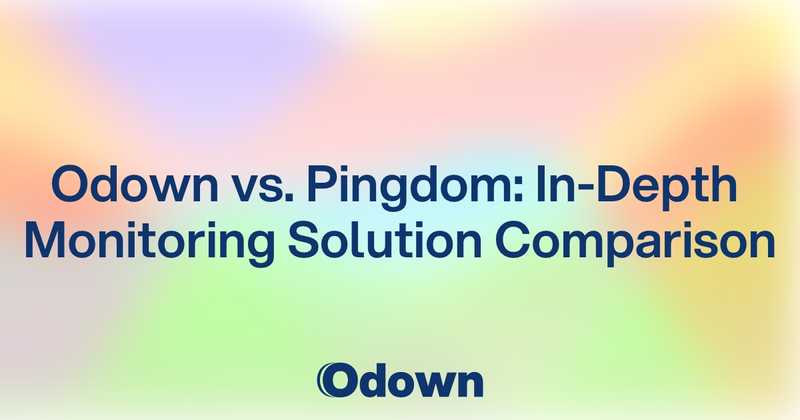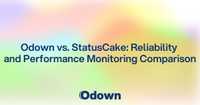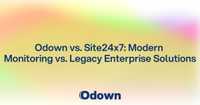Odown vs. Pingdom: In-Depth Monitoring Solution Comparison
When selecting a website monitoring solution, organizations need to carefully evaluate their options to find the best fit for their specific requirements. Both Odown and Pingdom are established players in the website and application monitoring space, each with their own approaches to helping businesses maintain digital reliability. This guide examines the key areas to consider when comparing these monitoring solutions, providing a framework for evaluation rather than specific feature comparisons that may change over time.
As web applications become increasingly complex, choosing the right monitoring solution is more important than ever. This comparison will help you understand the general categories and considerations for evaluation, enabling you to conduct your own detailed assessment based on current offerings.
Feature Set Comparison: How to Evaluate Monitoring Solutions
When comparing Odown and Pingdom, consider these key feature categories and evaluation criteria. Features and implementations evolve over time, so we recommend checking each provider's current documentation for the most up-to-date capabilities.
Core Monitoring Capabilities to Evaluate
Uptime Monitoring Considerations
When evaluating uptime monitoring capabilities, consider these factors:
- Types of protocols and endpoints supported (HTTP, HTTPS, TCP, DNS, etc.)
- Flexibility of check intervals and their minimum/maximum ranges
- Number and geographic distribution of testing locations
- Support for modern protocols like IPv6
- Configuration options for request methods and headers
- Authentication support for secured endpoints
Both Odown and Pingdom offer uptime monitoring with various configuration options. Check their current documentation for specific implementation details and supported protocols.
Performance Monitoring Considerations
For performance monitoring capabilities, assess these aspects:
- Page load time tracking methodologies
- Types of performance metrics collected
- Resource-level analysis capabilities
- Support for modern metrics like Core Web Vitals
- Transaction monitoring capabilities
- Real User Monitoring (RUM) offerings
- Historical data retention policies
Website performance monitoring approaches vary between providers, with different implementations of synthetic and real user monitoring. Check current documentation for specific methodologies and metrics supported by each platform.
Additional Monitoring Types
Consider whether these specialized monitoring capabilities are important for your needs:
- SSL certificate monitoring
- Domain expiration tracking
- API endpoint monitoring
- WebSocket support
- Multi-step transaction capabilities
- Content verification options
- Custom success criteria flexibility
Alert Systems and Notification Channels
Effective monitoring requires reliable alerting mechanisms. Consider these factors when evaluating alert systems:
Alert Delivery Channels
Common notification channels to evaluate include:
- Email alerts
- SMS notifications
- Phone call alerts
- Mobile push notifications
- Webhook support
- Chat platform integrations (Slack, Microsoft Teams, etc.)
- Incident management integrations (PagerDuty, OpsGenie, etc.)
- Custom integration capabilities via API
Alert Configuration Options
Important alerting features to consider:
- Alert escalation capabilities
- Team-based alert routing
- Schedule-based alert rules
- Maintenance window support
- False positive prevention mechanisms
- Alert grouping options
- Customization of alert messages and content
Reporting and Analytics Capabilities
Evaluate the reporting features that help organizations understand performance trends:
Important Reporting Features
Key reporting capabilities to assess:
- Uptime report formats and detail levels
- Performance trend visualization options
- SLA reporting and compliance tracking
- Dashboard customization capabilities
- Data export formats and methods
- API access for custom reporting needs
- Scheduled report delivery options
Advanced Reporting Considerations
For organizations with complex needs, evaluate:
- Report branding and customization options
- Team performance reporting
- Correlation capabilities between different services
- Business impact analysis features
- Benchmark comparison reporting
- Options for sharing reports with stakeholders
Integration Ecosystem Assessment
Modern monitoring solutions should integrate with your existing technology stack:
Types of Integrations to Evaluate
- Developer tool integrations (APIs, webhooks, CI/CD pipelines)
- Source control integrations (GitHub, Bitbucket, GitLab)
- Communication platforms (Slack, Microsoft Teams, etc.)
- Incident management systems (PagerDuty, OpsGenie, etc.)
- IT service management tools (ServiceNow, Jira, etc.)
- Automation platforms (Zapier, etc.)
- Analytics and business intelligence tools
For a deeper understanding of how monitoring can be extended to database systems, see our guide on Database Performance Monitoring, which explores complementary approaches to database health tracking.
Pricing and Value Considerations
Pricing structures for monitoring services frequently change and often include various tiers and options. Instead of specific pricing, consider these evaluation factors:
Pricing Model Evaluation
When comparing pricing models, consider:
Plan Structure Assessment
- Entry-level pricing tier availability
- Free tier or trial options
- Number of monitors included at each tier
- User access limitations
- Alert volume limitations
- Minimum check frequency limitations
- Add-on costs for additional features
Enterprise Considerations
- Availability of volume-based pricing
- Custom SLA options
- Volume discount structures
- Professional services availability
- Multi-year commitment discounts
Value Analysis Framework
When assessing value, consider these use case scenarios:
Small Business/Startup Considerations
- Initial cost for basic monitoring needs
- Scalability as monitoring needs grow
- Essential features available at entry-level pricing
- Free tier limitations and capabilities
Mid-Size Business Evaluation
- Cost-effectiveness as monitor counts increase
- Team collaboration feature availability
- Integration capabilities with existing tools
- Support level included at mid-tier pricing
Enterprise Requirements
- Customization options for complex environments
- Support for large-scale deployments
- Enterprise-grade security features
- Dedicated support availability
- Professional services offerings
Total Cost of Ownership Factors
Beyond subscription costs, evaluate:
- Implementation complexity and resource requirements
- Training needs for team members
- Ongoing maintenance considerations
- Integration development costs
- Alert management overhead
User Experience and Implementation
The user experience and ease of implementation significantly impact the overall value of a monitoring solution.
User Interface Evaluation Criteria
When assessing monitoring platforms, consider these interface aspects:
Dashboard Organization
- Service-centric vs. check-based organization
- Visual status indication methods
- Metric and alert integration approaches
- Dashboard customization capabilities
Mobile Experience
- Mobile application availability
- Core features available on mobile
- Mobile alert management capabilities
- Mobile responsiveness of web interface
Implementation Assessment
Consider these aspects of the implementation process:
Setup Process Evaluation
- Account creation requirements
- Initial monitor configuration process
- Availability of predefined templates
- Bulk configuration capabilities
- Default alert setup process
- Initial dashboard configurations
Advanced Configuration Considerations
- Multi-step transaction configuration complexity
- Alert routing setup process
- Team permission management approach
- Advanced check configuration options
Support Evaluation
Support quality varies by provider and plan level:
Support Channels to Assess
- Available communication channels (email, chat, phone)
- Self-service resources (knowledge base, tutorials)
- Community support options
- Enterprise support offerings
Support Quality Considerations
- Typical response times by support channel
- Support availability hours
- Escalation processes for critical issues
- Support level variations by plan tier
Migration Consideration Framework
For organizations considering switching platforms, evaluate:
- Data export capabilities from current platform
- Import options for new platform
- Integration reconfiguration requirements
- Historical data migration possibilities
- Parallel operation feasibility during transition
Evaluation Framework for Different Use Cases
Different organization types and industries may prioritize different aspects of monitoring solutions.
Use Case Evaluation Examples
E-commerce Website Monitoring Key evaluation criteria:
- Transaction monitoring capabilities for checkout flows
- Performance monitoring for product pages
- Real user experience tracking
- Alert reliability for revenue-impacting issues
API-Based Service Monitoring Important factors:
- Protocol support for your specific API types
- Authentication handling capabilities
- Performance tracking granularity
- Integration with your development workflow
Global Content Delivery Monitoring Critical considerations:
- Geographic distribution of test locations
- Regional performance comparison capabilities
- CDN-specific monitoring features
- Real user monitoring with geographic segmentation
Industry-Specific Evaluation Framework
Different industries typically prioritize different monitoring aspects:
Financial Services
- Security and compliance capabilities
- Reliability monitoring features
- Detailed SLA reporting options
- Alert escalation sophistication
Healthcare
- Uptime monitoring reliability
- Performance tracking for patient-facing applications
- Security feature compliance
- Integration with healthcare systems
Media and Publishing
- Content delivery performance monitoring
- CDN integration capabilities
- Audience experience tracking
- High-volume content monitoring scalability
Decision Framework: Making the Right Choice
Based on your organization's specific needs, develop a structured evaluation approach.
Key Decision Factors
When evaluating monitoring solutions, prioritize these factors according to your needs:
- Required Monitor Volume: Assess how many endpoints, pages, and transactions need monitoring
- Budget Parameters: Determine your monitoring budget per resource
- Team Access Needs: Consider how many users need platform access
- Protocol Requirements: Identify any specialized protocol monitoring needs
- Geographic Coverage: Assess the importance of global test locations
- Integration Requirements: List which tools must integrate with your monitoring
- Preferred Alert Channels: Identify critical notification methods for your team
Recommended Evaluation Process
To make an informed decision:
- Define Requirements: Document your specific monitoring needs and priorities
- Request Current Information: Contact both providers for the latest feature and pricing details
- Trial the Services: Utilize free trials or tiers to test actual functionality
- Check Reviews: Research current user reviews focusing on your priority areas
- Evaluate Support: Test the responsiveness of support during your trial
- Consider Growth: Factor in how your monitoring needs may expand over time
Both Odown and Pingdom offer website and application monitoring capabilities that continue to evolve. The best choice depends on your specific requirements, which should be evaluated against the most current offerings from each provider.
We recommend conducting a thorough evaluation based on your organization's unique needs, taking advantage of free trials, and considering future requirements when making your decision.



